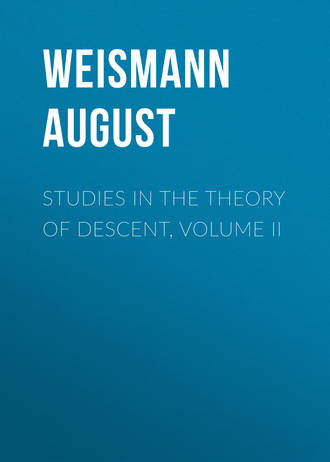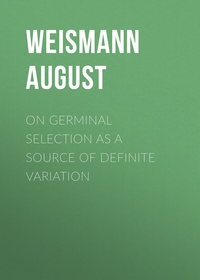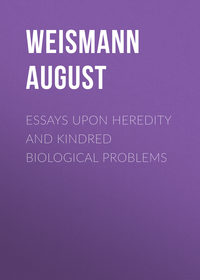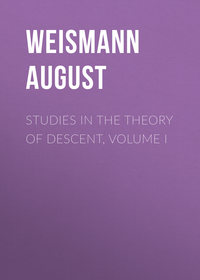 полная версия
полная версияStudies in the Theory of Descent, Volume II
87
Origin of Species, 6th ed. p. 252.
88
In plants also reversion forms show sterility in different degrees. Mr. Darwin has called my attention to the fact that the peloric (symmetrical) flowers which occasionally appear as atavistic forms in Corydalis solida are partly sterile and partly fertile. That in other causes of sterility, and above all by bastardizing, the reproductive power is lost in the most varying degrees, has been known since the celebrated observations of Kölreuter and Gärtner. [Eng. ed. An Orchid (Catasetum tridentatum) has the sexes separate, and the male flowers (Myanthus barbatus) differ considerably from the female (Monachanthus viridis); besides these, there occurs a form with bisexual flowers which must be considered as a reversion (Cat. tridentatum) and this is always sterile. Darwin, “Fertilization of Orchids,” 2nd ed. p. 199.]
89
As we do not know the origin of the “Paris Axolotl” I must restrict myself in the following remarks to Siredon Mexicanus (Shaw).
90
Mühlenpfordt, “Versuch einer getreuen Schilderung der Republik Mejico,” Hanover, 1844, vol. ii. p. 252.
91
[The specific gravity of sea water (Atlantic), according to the determinations of Mr. Buchanan on board the “Challenger,” at 15.56 °C. varies from 1.0278 to 1.0240. That of the water of the Dead Sea is 1.17205. – Watts’ “Dict. of Chemistry,” vol. v., table, p. 1017. R.M.]
92
Loc. cit. p. 252.
93
“Über die specifische Verschiedenheit des gefleckten und des schwarzen Erdsalamanders oder Molchs, und der höchst merkwürdigen, ganz eigenthümlichen Fortpflanzungsweise des Letzteren.” Isis, Jahrg. 1833, p. 527.
94
The experiments referred to have not been made known; I am indebted for them to a written communication kindly furnished by an esteemed colleague.
95
See Mühlenpfordt’s work already quoted, vol. i.
96
In the province of botany such a case has already been made known by Fritz Müller (Botan. Zeitung, 1869, p. 226; 1870, p. 149). I may be here permitted to quote a passage from the letter in which Dr. Müller calls attention to this interesting discovery. “As a proof of the possibility that a reversion form can again become a persistent character in a species or in the allied form of a particular district, I may refer you to an Epidendrum of the island of Santa Catharina. In all Orchids (with the exception of Cypripedium) only one anther is developed; in very rare cases well-formed anthers appear as reversions among the aborted lateral anthers of the inner whorl. In the Epidendrum mentioned, these are however always present.”
97
[This species is interesting as being ovoviviparous, the young passing through the branchiate stage within the body of the mother. Some experiments, which were partially successful, were made by Fräulein v. Chauvin with a view to solve the question whether the branchiate stage could be prolonged by taking the larvæ directly from the mother before birth and keeping them in water. See “Zeit. für wissen. Zoo.” vol. xxix., p. 324. R.M.]
98
See Fatiot, “Les Reptiles et les Batraciens de la haute Engadine.” Geneva, 1873.
99
I can remember at Upper Engadine a peculiar kind of preserved beef, prepared by simply drying in the air; also the mummification of entire human bodies by drying in the open air, as is practised at Great St. Bernard.
100
“Faune des Vertébrés de la Suisse,” vol. iii. “Histoire Naturelle des Reptiles et des Batraciens.” Geneva, 1873.
101
See Wiedersheim, “Versuch einer gleichenden Anatomie der Salamandrinen.” Würzburg, 1875.
102
See Gené, “Memorie della Reale Acad. di Torino,” vol. i.
103
Rana esculenta never reaches Alpine regions, this species not having been found higher than 1100 meters. (Fatiot, loc. cit., p. 318.)
104
See also the excellent work upon Mexico by Mühlenpfordt already quoted, vol. i., pp. 69–76.
105
“Essai politique sur le Royaume de la Nouvelle Espagne,” 1805, p. 291.
106
[The expression made use of by the author, viz. “Diluvialzeit,” would perhaps be more in harmony with the views of English geologists if rendered as the “pluvial period,” thereby indicating the period of excessive rainfall which, according to Mr. Alfred Tylor, succeeded to and was a consequence of the thawing of the great glaciers which accumulated during the last glacial epoch. There is abundant evidence to show that during the latter period glacial action extended in North America at least as far south as Nicaragua. See Belt on “The Glacial Period in North America,” Trans. Nova Scotian Inst. of Nat. Sci. 1866, p. 93, and “The Naturalist in Nicaragua,” pp. 259–265. R.M.]
107
[Eng. ed. A memoir by Samuel Clarke has since been published upon the embryonic development of Amblystoma punctatum, Baird. Baltimore, 1879.]
108
[Eng. ed. See this author’s work, “Das Kopfskelet der Urodelen.” Leipzig, 1877, p. 149.]
109
[See preceding note 52. R.M.]
110
See note 226, p. 566.
111
[Prof. Semper also remarks (“Animal Life,” note 47, p. 430) with reference to the Axolotl of Lake Como in the Rocky Mountains, which he states always becomes transformed into Amblystoma Mavortium, that this metamorphosis “takes place in the water, and the Amblystomas, so long as they are little, actually live exclusively in the water, as I know by my own experience. A young Amblystoma which I kept alive for a long time, never went out of the water of its own free will, while one nearly twice as large lives entirely on land and only takes a bath now and then. It always goes into the water when the temperature of the air in the cellar, in which my aquaria stand, falls below that of the water – down to about 6° or 8 °C.” This statement appears to suggest that the effect of temperature may be a factor in some way concerned in these interesting cases of transformation, and would in any case be well worthy of experimental investigation. Some further details concerning the Siredon Lichenoides of Lake Como have been recently published by Mr. W. E. Carlin (Proc. U.S. National Museum, June, 1881). The lake, which is shallow, is fed by a constant stream of fresh water, but the water of the lake is intensely saline. The Siredon never enter the fresh water stream, but congregate in large numbers in the alkaline waters of the lake. “When about one hundred and fifty were placed in fresh water they seemed to suffer no inconvenience, but it had a remarkable effect in hastening their metamorphosis into the Amblystoma form. Of an equal number kept in fresh water and in the lake water, quite a change occurred with the former after twenty-four hours, while the latter showed no change after several days of captivity. Those that were kept well fed in jars usually began to show a slight change in from two to three weeks, and all of them completed the change into the Amblystoma inside of six weeks, while in some kept, but not specially fed, there were but three changes in three months.” (Nature, Aug. 25th, 1881, p. 388.) R.M.]
112
[Some experiments on the transformation of the Crustacean Artemia Salina into A. Milhausenii by gradually increasing the saltness of the water, and conversely, the transformation of A. Milhausenii into A. Salina by diminishing the saltness of the water, have been made by Schmankewitsch (Zeitschrift f. wiss. Zool. xxv. Suppl. 103 and xxix. 429), but the changes which occur here are much less considerable than in the case of the Axolotl. R.M.]
113
“Reden und kleinere Aufsätze, Th. II.: Studien aus dem Gebiete der Naturwissenschaften.” St. Petersburg, 1876, p. 81.
114
This obviously does not imply that the naturalist should not investigate Nature’s processes, and not only correlate these, but also work them up into a universal conception; this is indeed both desirable and necessary if natural knowledge is to be regarded in its true value. The naturalist by this means becomes a philosopher, and the vitality of the so-called “natural philosopher” has been inspired, not by the necessity for investigation, but by philosophy proper.
115
[The discovery here referred to is the synthesis of urea by Wöhler in 1828 (Pogg. Ann. xii., 253; xv. 619), by the molecular transformation of ammonium cyanate. Since that period large numbers of organic syntheses have been effected by chemists, and many of the compounds formerly supposed to be essential products of life have been built up in the laboratory from their inorganic elements. The division of chemistry into “organic” and “inorganic” is thus purely artificial, and is merely retained as a matter of convenience, the former division of the science being defined as the chemistry of the carbon compounds. R.M.]
116
“Wahreit und Irrthum im Darwinismus.” Berlin, 1875.
117
[Eng. ed. I have been reproached by competent authorities for having clothed my ideas upon the theory of selection in the form of a reply to Von Hartmann. I willingly admit that this author cannot be considered as the leader of existing philosophical views upon the theory of descent in Germany; Frederick Albert Lange has certainly a much greater claim to this position. Lange does not however combat this theory; he accepts and develops it most beautifully and lucidly on a sound philosophical basis in such a manner as has never been done before from this point of view (“Geschichte des Materialismus,” 3rd. ed., 1877, vol. ii. pp. 253–277). On most points I can but agree with Lange. Von Hartmann, however, whose objections appeared to me to be supported by a wide scientific knowledge, afforded me a suitable opportunity of developing my own ideas upon some essential points in the theory of selection. In this sense only have I attempted to interfere with this author, the refutation of his views, as such, having been with me a secondary consideration.] [The chief exponent of the doctrine of organic evolution in this country is Mr. Herbert Spencer, in whose “Principles of Biology,” vol. i. chap. xii., will be found a masterly treatment of the theory of descent from a “mechanical” point of view. R.M.]
118
[The above views on the nature of variability, which were also broadly expressed in the first essay “On the Seasonal Dimorphism of Butterflies” (pp. 114, 115), are fully confirmed by Herbert Spencer (loc. cit. chaps. ix. and x.), and more recently by A. R. Wallace in an article on “The Origin of Species and Genera” (Nineteenth Century, vol. vii., 1880, p. 93). See also some remarks by Oscar Schmidt in his “Doctrine of Descent and Darwinism,” Internat. Scien. Ser. 3rd. ed. 1876, p. 173. R.M.]
119
[This law has been beautifully applied by Herbert Spencer in order to explain why, with an unlimited supply of food, an organism does not indefinitely increase in size. “Principles of Biology,” vol. i. p. 121–126. R.M.]
120
[Eng. ed. This idea, formerly expressed by me, occurs also in Lange (“Geschichte des Materialismus,” ii. 265), and is there exemplified in a very beautiful manner by illustrations from modern chemistry. Lange compares what I have termed above the “physical constitution” of the organism to the chemical constitution of one of those organic acids which by substitution of single elements may become transformed into more complicated acids, but which, as it were, always undergo “further development” in only one determined and narrowly restricted course. Here, as with the organism, the number of possible variations is very great, but is nevertheless limited, since “what can or cannot arise is determined beforehand by certain hypothetical properties of the molecule.”]
121
“Origin of Species.” 4th German ed., p. 19; 5th English ed., p. 6.
122
[Mr. A. R. Wallace, in his article last referred to, quotes some most valuable measurements of mammals and birds, showing the amount of variation of the different parts. These observations were published by J. A. Allen, in a memoir “On the Mammals and Winter Birds of East Florida,” &c. (Bulletin of the Museum of Comparative Zoology at Harvard College, Cambridge, Mass., vol. ii. No. 3.) R.M.]
123
[See note 142, p. 310. R.M.]
124
“Die Darwin’sche Theorie,” Dorpat, 1875.
125
[A certain number of instances of mimicry are known to occur between species both of which are apparently nauseous. A most able discussion of this difficult problem is given by Fritz Müller, in the case of the two butterflies Ituna Ilione and Thyridia Megisto, in a paper published in Kosmos, May, 1879 (p. 100). The author shows by mathematical reasoning that such resemblances between protected species can be accounted for by natural selection if we suppose that young birds and other insect persecutors have to learn by experience which species are distasteful and which can be safely devoured. See also Proc. Ent. Soc. 1879, pp. xx-xxix. R.M.]
126
See Haeckel’s “Generelle Morphologie,” ii. 107.
127
“Über die Berechtigung der Darwin’schen Theorie,” Leipzig, 1868.
128
“Populäre wissenschaftl. Vorträge,” vol. ii., Brunswick, 1871, p. 208.
129
“Das Unbewusste vom Standpunkte der Physiologie u. Descendenztheorie,” Berlin, 1872, p. 89. The second edition appeared in 1877, in Von Hartmann’s own name.
130
“Über die Berechtigung,” &c., Leipzig, 1868. In this work will be found briefly laid down the theoretical conception of variability here propounded somewhat more broadly. [In the last edition of the “Origin of Species” Darwin states, with respect to the direct action of the conditions of life as producing variability, that in every case there are two factors, “the nature of the organism and the nature of the conditions.” 6th ed. p. 6. R.M.]
131
[Although hardly necessary to the evolutionist, it may perhaps be well to remind the general reader, that all experiments upon spontaneous generation, or abiogenesis, have hitherto yielded negative results; no life is produced when the proper precautions are taken for excluding atmospheric germs. But although we have so far failed to reproduce in our laboratories the peculiar combination of conditions necessary to endow colloidal organic matter with the property of “vitality,” the consistent evolutionist is bound to believe, from the analogy of the whole of the processes of nature, that at some period of the earth’s history the necessary physical and chemical conditions obtained, and that some simple form or forms of life arose “spontaneously,” i. e. by the operation of natural causes. R.M.]
132
See Haeckel’s “Generelle Morphologie,” vol. ii. p. 203, and Seidlitz, “Die Darwin’sche Theorie,” 1875, p. 92 et seq.
133
[In a recently published work by Dr. Wilhelm Roux this author has attempted to work out the idea of an analogy between the struggle for existence and survival of the fittest in individuals and species, and the struggle for existence and survival of the parts in the individual organism. See “Der Kampf der Theile im Organismus: ein Beitrag zur Vervollständigung der mechanischen Zweckmässigkeitslehre,” Leipzig, 1881. R.M.]
134
[Eng. ed. Meanwhile it has been shown by Oscar Schmidt that Von Hartmann, under the name of “the Unconscious,” re-invests the old vital force with some portion of its former power. “Die naturwissenschaftlichen Grundlagen der Philosophie des Unbewussten,” Leipzig, 1877, p. 41.]
135
Loc. cit. p. 175.
136
Loc. cit. p. 156.
137
“Über die Cuninen-Knospenähren im Magen von Geryonien.” Reprint from “Mittheil. des naturwiss. Vereines,” Graz, 1875.
138
[See Darwin’s “Origin of Species,” 6th ed. pp. 33, 34, and 201–204. R.M.]
139
[Eng. ed. See Kant’s “Allgemeine Naturgeschichte und Theorie des Himmels.”]
140
“Das Unbewusste vom Standpunke der Physiologie und Descendenz-Theorie,” Berlin, 1872, p. 16.
141
[Eng. ed. See Lotze’s “Mikrokosmos,” 1st ed., vol. iii. pp. 477–483.]
142
See Helmholtz’s “Populäre wissenschaftl. Vorträge,” vol. ii., Brunswick, 1872.
143
See also Fr. Vischer’s “Studien über den Traum. Beilage zur Augsburger Allgem. Zeitung,” April 14th, 1876. Haeckel also includes this idea in his recent essay already quoted, “Die Perigenesis der Plastidule,” Berlin, 1876, p. 38 et seq.
144
See Von Hartmann, loc. cit. p. 158.






